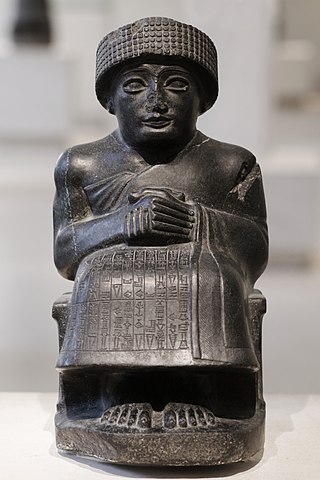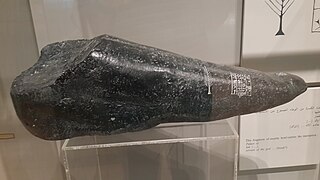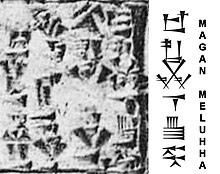
The Akkadian Empire was the first known ancient empire of Mesopotamia, succeeding the long-lived civilization of Sumer. Centered on the city of Akkad and its surrounding region, the empire would unite Akkadian and Sumerian speakers under one rule and exercised significant influence across Mesopotamia, the Levant, and Anatolia, sending military expeditions as far south as Dilmun and Magan in the Arabian Peninsula.

Sumer is the earliest known civilization, located in the historical region of southern Mesopotamia, emerging during the Chalcolithic and early Bronze Ages between the sixth and fifth millennium BC. Like nearby Elam, it is one of the cradles of civilization, along with Egypt, the Indus Valley, the Erligang culture of the Yellow River valley, Caral-Supe, and Mesoamerica. Living along the valleys of the Tigris and Euphrates rivers, Sumerian farmers grew an abundance of grain and other crops, a surplus which enabled them to form urban settlements. The world's earliest known texts come from the Sumerian cities of Uruk and Jemdet Nasr, and date to between c. 3350 – c. 2500 BC, following a period of proto-writing c. 4000 – c. 2500 BC.

Gudea (Sumerian: 𒅗𒌤𒀀, Gu3-de2-a) was a ruler (ensi) of the state of Lagash in Southern Mesopotamia, who ruled c. 2080–2060 BC (short chronology) or 2144–2124 BC (middle chronology). He probably did not come from the city, but had married Ninalla, daughter of the ruler Ur-Baba (2164–2144 BC) of Lagash, thus gaining entrance to the royal house of Lagash. He was succeeded by his son Ur-Ningirsu. Gudea ruled at a time when the center of Sumer was ruled by the Gutian dynasty, and when Ishtup-Ilum ruled to the north in Mari. Under Gudea, Lagash had a golden age, and seemed to enjoy a high level of independence from the Gutians.

Dilmun, or Telmun, was an ancient East Semitic-speaking civilization in Eastern Arabia mentioned from the 3rd millennium BC onwards. Based on contextual evidence, it was located in the Persian Gulf, on a trade route between Mesopotamia and the Indus Valley civilisation, close to the sea and to artesian springs. Dilmun encompassed Bahrain, Kuwait, and eastern Saudi Arabia. This area is certainly what is meant by references to "Dilmun" among the lands conquered by King Sargon II and his descendants.

The Eastern Province, also known as the Eastern Region, is the easternmost of the 13 provinces of Saudi Arabia. It is the nation's largest province by area and the third most populous after the Riyadh and Mecca provinces. In 2017, the population was 4,900,325. Of these, 3,140,362 were Saudi citizens and 1,759,963 were foreign nationals The province accounts for 15.05% of the entire population of Saudi Arabia and is named for its geographical location relative to the rest of the kingdom.

Meluḫḫa or Melukhkha is the Sumerian name of a prominent trading partner of Sumer during the Middle Bronze Age. Its identification remains an open question, but most scholars associate it with the Indus Valley civilisation.

The Third Dynasty of Ur, also called the Neo-Sumerian Empire, refers to a 22nd to 21st century BC Sumerian ruling dynasty based in the city of Ur and a short-lived territorial-political state which some historians consider to have been a nascent empire.

The First Dynasty of Ur was a 26th-25th century BCE dynasty of rulers of the city of Ur in ancient Sumer. It is part of the Early Dynastic period III of the history of Mesopotamia. It was preceded by the earlier First Dynasty of Kish and the First Dynasty of Uruk.

Uqair, alternatively spelled as al-'Uqair, Uqayr, and Ogair, is an ancient seaport city in the Al-Ahsa Governorate of the Eastern Province of Saudi Arabia. It is the first seaport in the Persian Gulf and has been linked by some to the ancient city of Gerrha mentioned in Greek and Roman sources. The site was also the location of the conference at which the Uqair Protocol of 1922 was issued, which helped to establish the borders of modern Saudi Arabia.

Eastern Arabia (Bahrain), is a region stretched from Basra to Khasab along the Persian Gulf coast and included parts of modern-day Bahrain, Kuwait, Iraq, Eastern Saudi Arabia, United Arab Emirates, Qatar, Oman. The entire coastal strip of Eastern Arabia was known as "Bahrain" for a millennium.

The Early Dynastic period is an archaeological culture in Mesopotamia that is generally dated to c. 2900 – c. 2350 BC and was preceded by the Uruk and Jemdet Nasr periods. It saw the development of writing and the formation of the first cities and states. The ED itself was characterized by the existence of multiple city-states: small states with a relatively simple structure that developed and solidified over time. This development ultimately led to the unification of much of Mesopotamia under the rule of Sargon, the first monarch of the Akkadian Empire. Despite this political fragmentation, the ED city-states shared a relatively homogeneous material culture. Sumerian cities such as Uruk, Ur, Lagash, Umma, and Nippur located in Lower Mesopotamia were very powerful and influential. To the north and west stretched states centered on cities such as Kish, Mari, Nagar, and Ebla.
Bahrain is a nation in the Persian Gulf, in a strategical position in relation to the eastern coast of the Arabian Peninsula, Iran, Iraq and Oman.
Umm Al Nar is a Bronze Age culture that existed around 2600-2000 BCE in the area of the modern-day United Arab Emirates and Northern Oman. The etymology derives from the island of the same name which lies adjacent to the city of Abu Dhabi, the capital of the UAE, which provided early evidence and finds that came to define the period.

The bilateral relations between the Republic of Iraq and the Republic of India have traditionally been friendly and collaborative. Cultural interaction and economic trade between Indus Valley and Mesopotamia date back several millennia. The 1952 Treaty of Friendship established and strengthened ties between contemporary India and Iraq. By the 1970s, Iraq was regarded as one of India's closest allies in the Middle East.
Imports to Ur reflect the cultural and trade connections of the Sumerian city of Ur. During the period of the Early Dynastic III royal cemetery, Ur was importing elite goods from geographically distant places. These objects include precious metals such as gold and silver, and semi-precious stones, namely lapis lazuli and carnelian. These objects are all the more impressive considering the distance from which they traveled to reach Mesopotamia and Ur specifically.
Ikaros was the Hellenistic name for what is now the Failaka Island of Kuwait. It is located 50 kilometres (31 mi) southeast of the spot where the Tigris and Euphrates empty into the Persian Gulf. For thousands of years, the island served as a strategic point in the Persian Gulf that would enable its ruler to control the lucrative trade that passed through the area; the island has been a strategic location since the rise of the Sumerian city-state of Ur in Mesopotamia.

Inzak was the main god of the pantheon of Dilmun. The precise origin of his name remains a matter of scholarly debate. He might have been associated with date palms. His cult center was Agarum, and he is invoked as the god of this location in inscriptions of Dilmunite kings. His spouse was the goddess Meskilak. A further deity who might have fulfilled this role was dPA.NI.PA, known from texts from Failaka Island.

Indus–Mesopotamia relations are thought to have developed during the second half of 3rd millennium BCE, until they came to a halt with the extinction of the Indus valley civilization after around 1900 BCE. Mesopotamia had already been an intermediary in the trade of lapis lazuli between the Indian subcontinent and Egypt since at least about 3200 BCE, in the context of Egypt-Mesopotamia relations.
The Sumerian economy refers to the systems of trade in ancient Mesopotamia. Sumerian city-states relied on trade due to a lack of certain materials, which had to be brought in from other regions. Their trade networks extended to places such as Oman, Arabia, Anatolia, the Indus River Valley, and the Iranian Plateau. Sumerians also bought and sold property, but land tied to the temples could not be traded. There were three types of land—Nigenna, Kurra, and Urulal—and only Urulal land could be traded; Nigenna land belonged to the temple, while Kurra land belonged to the people working in the temple. Within Sumer, the Sumerians could use silver, barley, or cattle as currency
Meskilak or Mesikila was one of the two main deities worshiped in Dilmun. The other well attested member of the pantheon of this area was Inzak, commonly assumed to be her spouse. The origin of her name is a subject of scholarly dispute. She is also attested in texts from Mesopotamia, where her name was reinterpreted as Ninsikila. A different deity also named Ninsikila was the spouse of Lisin, and might have started to be viewed as a goddess rather than a god due to the similarity of the names. Under her Mesopotamian name Meskilak appears in the myths Enki and Ninhursag and Enki and the World Order, in which she is associated with Dilmun.
















